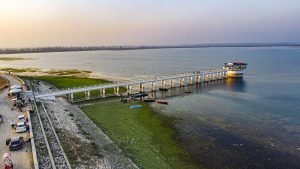Rana Tharu community’s fascination with Pandalu farming – Himal Sanchar
Kanchanpur: The Rana Tharu community living in Kanchanpur and Kailali is fond of Pindalu farming. Pindalu is a vegetable crop that is easily seen in the fields of these communities.
These communities have been cultivating it since ancient times. Nutritious Pindalu vegetables are liked by the community. Pindalu is a vegetable crop that these communities have been cultivating continuously since the nomadic era. Pindalu leaves, stems and songs are used as vegetables.
According to Bale Rana, ward president of Shuklafanta municipality-12, Pindalu is healthier than vegetables and is rich in protein and carbohydrates.
Pindaloo has been used as a medicine since ancient times to purify the blood and remove skin related diseases. He said, “The intake of Pindalu vegetables helps in rejuvenating the body and also helps in relieving mental stress.”
He said that if the bleeding stops, Pindalu’s stalk can be stopped. Vegetables of Pindalu leaves can increase the amount of milk in the breast of the lactating mother, brighten the face and relieve urinary irritation. He has put two katthas on the ground. He continues to cultivate Pindalu every year. He said, “Pindlukheti has been in vogue since the time of our ancestors.”
Rana, who do not cultivate Pindalukheti, is called Rana, Rana. Sown from the second week of May, Pindalu is dug in October. Pindalu farming is also being done like traditional potato farming. After depositing the seedlings in straw bags, the remaining seedlings are kept indoors for year-round consumption. If a sufficient amount of pindalu is produced for the house, it is taken to the market and sold.
Pindalu is made into vegetables, added to lentils and even eaten as a polar. Itwaria Rana said, “The taste of Pindalu is different because it tastes different. It is also in high demand in the market.” Since the introduction of pine, many families have been expanding the area of land for Pindalu farming.
Pindalu is currently sold in the market at the rate of 50 per kg. The Pindalu market cultivated by the Rana Tharu community is sold hand to hand as it is tastier than Pindalu of various castes. According to Fagu Rana, each family of the Rana Tharu community is currently selling 10,000 to 20,000 Pindalu in the market.
He said that his cultivation has expanded after earning good income from sandalwood, loam and loam soil. Due to animals and pests, farmers who cultivate Pindalukti do not suffer from new crops. Pindlukheti prevails in 110 villages inhabited by Rana Tharu of Kanchanpur. Ram Chandra Bhatta, head of Krishi Gyan Kendra of Kanchanpur, said that the new community is cultivating Pindalukheti, although the community is cultivating it. According to him, the Rana Tharu communities in Kailali and Kanchanpur are majority in Pindalukhi cultivating over 20 hectares of land.
He said that Pindalu’s songs are full of starch. He said that no demand has been made from the farmers for the extension of Pindalukti, including grants. Pindalukheti requires 21 to 27 degree Celsius temperature. Pindaloo is produced in an area of 10 to 12 tons per hectare.








